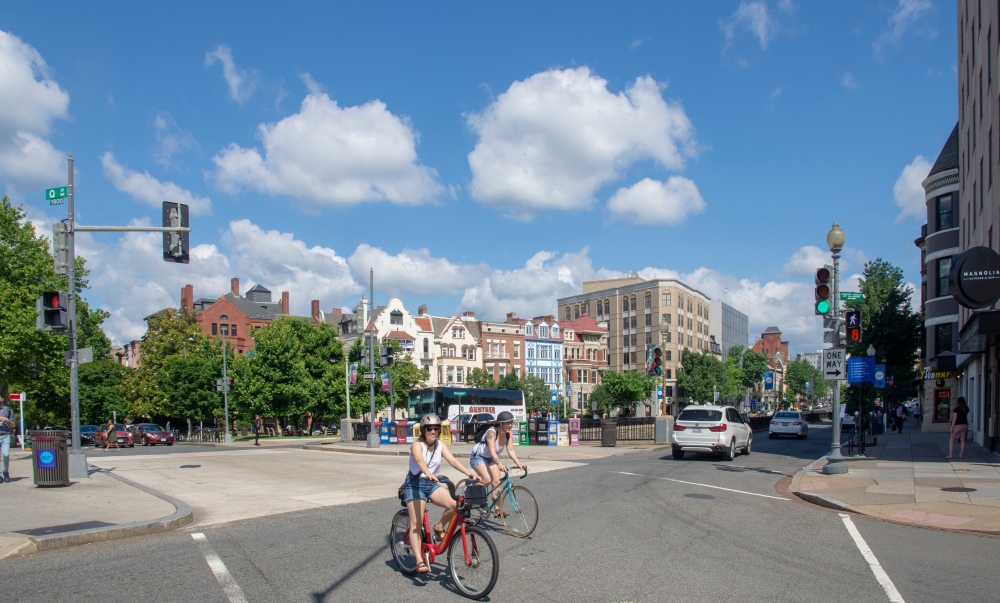Rents are high, and childcare is getting even more expensive. So, where can renters with children catch a break?
Americans are having fewer children. A leading reason? Childcare is too expensive. In fact, 40% of families struggle to find an affordable option.
The typical family spends between 9% and 16% of their annual income on full-day care for just one child. The government considers spending anything over 7% of a household’s annual income on childcare unaffordable.
In some cases, childcare costs more than rent, a mortgage, or even college tuition. Childcare prices have jumped 263% since 1990, nearly double the 133% rise in inflation. And while federal grants are meant to help underserved families, 88% of eligible children don’t receive financial aid.
At the same time, housing costs are up. Rents have risen 21% since before the pandemic and may climb more as construction falls and tariffs shake the economy. Together, these rising costs are pushing the price of raising a child to new highs.
So, where can renters with kids actually afford both housing and childcare? In this Redfin article, we looked at the combined monthly cost of rent and childcare, ranking the 10 most affordable cities for residents making the local median income.

1. Houston, TX
- Share of income spent on childcare + rent: 26.4%
- Average monthly childcare + rent costs: $1,984 ($735 + $1,249)
- Median monthly household income: $7,514
Houston ranks as the most affordable major city for renters with children. Thanks to the city having some of the lowest rent prices in the country, families in Houston spend a smaller share of their income on housing and childcare than in any other city we analyzed.
That said, affordability doesn’t mean the situation is easy. Many families still struggle with rising childcare costs and are unable to afford basic necessities.
Zooming out to the state level, the affordability crisis becomes even clearer: Nearly 95,000 families are on months-long waitlists for childcare subsidies, forcing them to go without care or pay above their means. A recent report found the state loses over $9 billion annually due to childcare-related challenges – primarily parents who are forced to reduce work hours or leave jobs to care for their children.
Houston apartments for rent | Houston houses for rent | Houston homes for sale

2. Dallas, TX
- Share of income spent on childcare + rent: 27.4%
- Average monthly childcare + rent costs: $2,306 ($851 + $1,455)
- Median monthly household income: $8,417
Dallas is the second-most affordable major city for renters with children. With a thriving job market, green space, and plenty to do, it’s an attractive option for those looking to balance affordability with a high quality of life.
Even so, many Texas parents struggle to pay for pre-kindergarten care. Infant care centers – the most expensive form of childcare – can charge well over $11,000 per year. In certain areas, there aren’t any facilities at all, making it near-impossible for parents to hold down a job and care for their kids. That helps explain why 60% of nonworking parents cite the lack of accessible childcare as a primary reason they don’t participate in the workforce.
There have been efforts to improve care access. Dallas County recently launched an employer match program to improve care access. Participating employers can offer workers $3,000 per year in childcare assistance, which the county will match.
Dallas apartments for rent | Dallas houses for rent | Dallas homes for sale

3. Atlanta, GA
- Share of income spent on childcare + rent: 28.3%
- Average monthly childcare + rent costs: $2,274 ($739 + $1,535)
- Median monthly household income: $8,048
Atlanta offers big-city energy and plenty of Southern charm, as well as some of the lowest childcare costs in the nation. Pair that with recent commitments to ensure that all children have access to care, and it stands out as an affordable option for parents.
That said, many people still can’t afford childcare. In some areas of Georgia, infant care without subsidies can even cost more than college. This is unaffordable for many families, especially single parents or lower-income households. Combined with the fact that 18% of Atlanta residents live in poverty, it’s clear that childcare remains out of reach for many.
Georgia does offer some help through programs like CAPS and BOOST, which are aimed at helping low-income families afford care. However, funding is severely limited. There is growing support from the state government to rein in costs, but progress remains slow.
Atlanta apartments for rent | Atlanta houses for rent | Atlanta homes for sale

4. Washington, D.C
- Share of income spent on childcare + rent: 29.7%
- Average monthly childcare + rent costs: $3,462 ($1,401 + $2,061)
- Median monthly household income: $11,672
The nation’s capital, Washington, D.C. is the fourth-most affordable city for renters with children. Even though costs are steep, D.C.’s high median income help offset the burden, keeping the share of income spent on rent and childcare below 30%. D.C. has the fourth-highest median household income in the country.
That’s not to say it’s affordable, though. A 2023 study put the median annual childcare cost in D.C. at over $24,000. Low-income parents are being hit especially hard, with only 5% of eligible families receiving government grants. These exceptionally high childcare costs have prompted some families to reconsider D.C. living.
To help ease the burden, D.C. became one of the first cities to offer universal pre-K back in 2009, which has helped boost school enrollment and maternal employment rates. The city recently announced that the program will be funded through 2026.
Washington, D.C. apartments for rent | Washington, D.C. houses for rent | Washington, D.C. homes for sale

5. Baltimore, MD
- Share of income spent on childcare + rent: 29.7%
- Average monthly childcare + rent costs: $2,753 ($1,147 + $1,606)
- Median monthly household income: $9,264
Baltimore has a lot to offer, from historic neighborhoods to its famous blue crabs. It also boasts one of the lowest childcare-plus-rent costs in the nation, with the typical family spending less than 30% of their income.
Even so, raising a young family isn’t cheap. Childcare alone averages $1,147 a month, and with rents continuing to rise, it’s no surprise that many families are struggling to afford the basics.
Parents are feeling the strain and looking for help. Maryland’s main support program for low-income families, the Child Care Scholarship Fund, was recently paused due to overwhelming demand and limited funding. Another initiative aims to expand childcare access specifically for federal workers who’ve been laid off or called back to the office — a step in the right direction, but far from a full solution.
Baltimore apartments for rent | Baltimore houses for rent | Baltimore homes for sale

6. St. Louis, MO
- Share of income spent on childcare + rent: 29.8%
- Average monthly childcare + rent costs: $2,174 ($899 + $1,275)
- Median monthly household income: $7,305
St. Louis is the sixth-most affordable major city for renters with young children. Average housing and childcare costs take up less than 30% of the median household income, making it a standout choice for those seeking a lower cost of living while still enjoying city life.
Still, like in many places, affordability doesn’t mean families have easy access to care. Missouri is home to widespread “childcare deserts,” with 78 of 115 counties lacking enough providers. This affects nearly half of the state’s children.
Parents who do live near a care center often struggle to find open slots or even get in touch with providers. While the number of deserts has improved since the pandemic, the shortage still costs Missouri $1.35 billion a year in lost productivity and economic opportunity.
St. Louis apartments for rent | St. Louis houses for rent | St. Louis homes for sale

7. Minneapolis, MN
- Share of income spent on childcare + rent: 29.9%
- Average monthly childcare + rent costs: $2,712 ($1,186 + $1,526)
- Median monthly household income: $9,058
Minneapolis stands out for its relatively low childcare costs and high quality of life. With abundant green space, strong public infrastructure, and a high median income, the city offers a more affordable path for families balancing rent and childcare – especially compared to other large metros.
However, it’s still largely unaffordable, especially for lower- and middle-income parents. The typical resident has to spend nearly a third of their income on childcare and rent.
Like in many cities, childcare providers in Minneapolis face an uphill battle. Staffing shortages, tight margins, and limited public funding make it hard to keep prices down or even stay open. Without meaningful government support, many providers may continue raising rates or be forced to shut their doors, leaving families with fewer and costlier options.
Minneapolis apartments for rent | Minneapolis houses for rent | Minneapolis homes for sale

8. Denver, CO
- Share of income spent on childcare + rent: 33.2%
- Average monthly childcare + rent costs: $3,154 ($1,434 + $1,720)
- Median monthly household income: $9,512
Denver may sit a mile high, but thanks to relatively strong incomes, housing and childcare costs are more manageable than in many other major metros. The typical family spends about a third of their income on both – high, but not uncommon in cities with similar living costs.
Still, the burden is uneven. Proportional to rents, Denver has the highest childcare costs in the country, eating up 15% of the median household income – more than double the federal affordability benchmark. Infant and toddler care can cost $25,000 and $21,000 respectively, even as providers operate on tight margins.
Statewide, single parents must spend 41% of their income on childcare alone. As a result, many parents decide to leave work to care for their children, leaving Colorado with $2.7 billion in lost revenue. As funding dries up nationwide, advocates are calling for the state to recommit to and reimagine its childcare system.
Denver apartments for rent | Denver houses for rent | Denver homes for sale

9. Chicago, IL
- Share of income spent on childcare + rent: 34.2%
- Average monthly childcare + rent costs: $2,787 ($1,037 + $1,750)
- Median monthly household income: $8,159
Chicago is the ninth-most affordable city for renters with children. Overall costs are on the lower end nationwide, especially among the largest cities. Those looking for a major metropolis with below-average childcare rates may be right at home in the Windy City.
Even so, people struggle to afford it. Full-time infant care averages around $1,000 per month, and when paired with rent, families spend more than a third of their monthly income just to cover the basics. The issue extends into the workforce, too. 20% of Illinois childcare workers live in poverty, and nearly 95% are women – most of whom are women of color.
Illinois offers support for parents through the Child Care Assistance Program (CCAP), which helps some working families cover care costs. There’s also a new pilot called EmPWR, which gives monthly cash to qualifying families involved in the child welfare system. Still, many Chicago children fall through the cracks, facing long waitlists or simply not enough aid to keep up with rising costs.
Chicago apartments for rent | Chicago houses for rent | Chicago homes for sale

10. Seattle, WA
- Share of income spent on childcare + rent: 34.3%
- Average monthly childcare + rent costs: $3,725 ($1,660 + $2,065)
- Median monthly household income: $10,844
Last on our list is Seattle, a city known for its tech companies, beautiful scenery, and months of drizzle. The typical Emerald City renter has to spend just over a third of their income on housing and childcare.
While Seattle families spend a slightly smaller share of their income on housing and childcare compared to many other high-cost cities, the actual dollar amounts remain steep. Infant care can exceed $2,000 per month, and families with multiple young children can face annual costs between $30,000 to $40,000 if they don’t qualify for subsidies. Washington’s recommended subsidy threshold is 60% of the state median income – or $56,763 – leaving many working families just above the cutoff.
Access is another major challenge. In King County, licensed care centers serve only about 21% of the estimated 325,000 children in need, and waitlists can stretch up to a year. Nonprofits like Launch help fill the gap with affordable early learning options, but demand far outweighs supply.
Seattle apartments for rent | Seattle houses for rent | Seattle homes for sale
The most expensive cities for renters with children
These cities are prohibitively expensive for most, with childcare costs often matching that of already-high rents. Below are the cities where renters with children spend the highest share of income on housing and childcare, along with the actual monthly costs.
| City | Share of income for childcare + rent | Monthly childcare + rent costs | Monthly childcare costs | Monthly rent costs |
| Miami, FL | 50.5% | $3,179 | $764 | $2,415 |
| New York, NY | 49.2% | $4,051 | $1,208 | $2,843 |
| Los Angeles, CA | 48.4% | $3,892 | $1,145 | $2,747 |
| Philadelphia, PA | 45.6% | $2,846 | $961 | $1,885 |
| Riverside, CA | 44.5% | $3,516 | $1,183 | $2,333 |
| San Diego, CA | 42.6% | $3,995 | $1,318 | $2,677 |
| Boston, MA | 42.1% | $4,396 | $1,609 | $2,787 |
| Tampa, FL | 40.6% | $2,658 | $865 | $1,793 |
| Phoenix, AZ | 38.3% | $2,393 | $918 | $1,475 |
| San Francisco, CA | 34.5% | $4,692 | $1,997 | $2,695 |
Methodology
This analysis is based on an original Redfin report, which analyzed childcare, rent, income, and inflation data for 20 major U.S. metro areas (“cities”) for which Redfin has sufficient data. Childcare costs were calculated assuming one child per household.
Median rent data was sourced from Redfin for the three months ending March 31, 2025. Childcare data is from the U.S. Department of Labor and was inflation-adjusted for March 2025 using Bureau of Labor Statistics Consumer Price Index (CPI) annual changes. Median household income data came from the U.S. Census Bureau and adjusted for March 2025.
.png)
 German (DE)
German (DE)  English (US)
English (US)  Spanish (ES)
Spanish (ES)  French (FR)
French (FR)  Hindi (IN)
Hindi (IN)  Italian (IT)
Italian (IT)  Russian (RU)
Russian (RU)  5 hours ago
1
5 hours ago
1









Comments